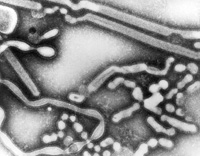Vaccine Shortage Complicates Flu Season
The Centers for Disease Control and Prevention (CDC) estimates that influenza kills more than 36,000 Americans each year. Another 200,000 are hospitalized every year with complications from the disease. Typically, the best way to prevent the spread of the flu is through vaccination. However, this year’s supply of flu vaccine is severely limited, because of production problems with the vaccine manufacturer, Chiron Inc.
Ruth Karron, MD, is an associate professor in the Department of International Health at the Bloomberg School of Public Health and a member of the Vaccine and Related Biological Projects Advisory Committee at the Food and Drug Administration (FDA), which helps determine how the annual flu shot will be formulated. The Office of Communications and Public Affairs spoke with her about the flu vaccine shortage and what the public should know about influenza.
Office of Communications & Public Affairs: The U.S. supply of flu vaccine was unexpectedly cut in half this year. With the limited supply, who should be vaccinated this year?
Ruth Karron: The highest priorities for flu vaccination are the very young and the elderly. In light of the shortage, the CDC is recommending flu vaccine for 6- to 24- month-old children, adults over age 65, anyone with serious underlying health problems, children receiving chronic aspirin therapy, pregnant women, health care workers providing direct patient care and caregivers and household contacts of infants under 6 months. However, infants under 6 months cannot receive the vaccine.

Influenza vaccine: Courtesy CDC
(Update: OnDecember 17, 2004, the CDC's Advisory Committee on Immunization Practices expanded the priority groups for inactivated influenza vaccination to include adults aged 50-64 and close contacts of persons in high-risk groups. They will now be eligible for influenza vaccination in areas where vaccine supply is sufficient to meet demand.)
The highest numbers of flu-related deaths each year are among seniors. Children younger than age 2 are at greater risk for hospitalization with the flu, which is why vaccination is recommended for that group.
There are two types of flu vaccine available and it is important to get the appropriate one. The flu shot comes from Aventis Pasteur and is made using killed virus. It’s approved for anyone 6 months and older. The FluMist vaccine is a nasal-spray manufactured by MedImmune Vaccines. The nasal-spray vaccine contains live attenuated influenza virus, which is a weakened form of the virus. It is only approved for healthy people 5 to 49 years of age. It is not recommend for infants and toddlers, pregnant women or people with serious health problems.
OC&PA: Should school-aged children be vaccinated?
RK: Yes, under normal circumstances when vaccine supplies are adequate. School-aged children are thought to be the biggest spreaders of influenza in the population. There has been some interesting work looking at the role of children as the sort of “Typhoid Marys” of influenza. Japan had a universal flu vaccination program for school-aged children, which they stopped. Researchers found an overall increase in pneumonia- and influenza-related mortality after the program was discontinued, which suggests that unvaccinated children were spreading the flu. The increased mortality was not among school-aged kids, but among the elderly.
OC&PA: Could we see more influenza-related illnesses or deaths because of the vaccine shortage?
RK: I think it’s impossible to predict, because there are so many variables to consider. It would really depend on how severe an epidemic we have, how much natural immunity we have in the population and how the vaccine is distributed.
OC&PA: Other than vaccination, what can people do to avoid contracting the flu?
RK: Common hygiene practices such as frequently washing your hands and avoiding crowds can help reduce your chances of contracting the flu. However, people at highest risk should still try to be vaccinated. If you are sick, you can help prevent others from becoming ill by covering your nose and mouth with a tissue when you cough or sneeze. It’s also important to stay home from work or school to avoid spreading germs if you are sick.
In some cases, doctors can prescribe antiviral drugs to reduce the duration of the illness by one or two days. We may see an increased use of these medications because many people won’t have access to the vaccine. However, the drugs are not practical for preventing infection in the general public, except in very specific situations.
OC&PA: Many people in the public say they have “the flu” to describe all sorts of illness. However, the flu, which the vaccine protects against, is really something different, correct?
RK: In most adults influenza is a very distinct illness separate from the typical cold or stomach illness. What distinguishes the flu from a cold is the sudden onset of the illness, high fever and shaking chills as well as more serious complications. Runny nose is not a prominent symptom of influenza. People talk a lot about the “stomach flu.” Influenza can cause gastrointestinal illness in small children, but it’s an uncommon symptom in adults. When people say they have the stomach flu, chances are they don’t have the flu at all.
We often hear people complain that the flu shot gave them the flu. The flu shot can’t give you the flu, because it’s made with killed virus. The likelihood is that they got the shot and then caught another illness that was circulating.
OC&PA: Each year, a new flu vaccine is required. How is it developed?

Influenza A virus: Courtesy CDC
RK: The World Health Organization and CDC conduct sentinel surveillance for influenza infections worldwide. The data are very useful because virus strains that are circulating in the Far East and the Southern hemisphere can tell us what strains are likely to appear here in the U.S. in the winter. The Vaccine and Related Biological Projects Committee, which advises the FDA, recommends which virus strains should be included in the vaccine for the upcoming flu season. That’s assuming the virus strains can be readily recovered in eggs and can grow.
It’s important to point out that the current vaccine crisis is an extreme example of what’s wrong with the vaccine supply system in the United States. Many people are quick to criticize industry, but making flu vaccine is really difficult. Companies do not receive the virus strains for the vaccine until March. They are expected, on a very tight timeline, to get an egg supply, grow the vaccine and have it ready to ship by September or October. They charge anywhere from $8 to $22 a dose, which is not a large profit margin. The problem in this country is that there is very little incentive for companies to make vaccine. Over the years, we’ve lost vaccine capacity, because many companies are getting out of the business. A couple of years ago, Wyeth pulled out of the flu vaccine manufacturing business.
OC&PA: We’ve also heard a great deal about avian flu in the past year. What is the risk there?
RK: Influenza infects a wide variety of mammals and birds. It’s an RNA virus and its genome is divided into segments. Influenza A viruses are characterized by their two surface glycoproteins, hemagglutinin (H) and neuraminidase (N). Right now, the human influenza viruses that typically circulate are H1N1 and H3N2.
There are also avian (bird) flu viruses that circulate, with different surface glycoproteins and internal genes. H5N1, H7N2 and H9N2 are some of the avian viruses that have circulated in recent years. H9 viruses infect humans on rare occasions and cause typical influenza illnesses. H7 viruses cause large epidemics in poultry annually. Occasionally, H7 viruses will infect and kill humans. H5 is the big player and that is the one that people are very worried about. The H5N1 virus is one that has been responsible for a number of deaths in Southeast Asia over the last few years. We think this virus is spread directly from birds to humans. Some evidence shows that the virus may also be spread from bird to pigs and then to humans.
Within influenza A viruses, there are two things that can happen. You can have a swapping and mixing of genes, which is called antigenic shift. When antigenic shift occurs, you have a new virus. If the virus picks new characteristics that make it more virulent and easily transmittable from human to human, you can have a pandemic. The fear with the H5 avian virus is that it could either adapt directly to the human host or mix and match genes with a human influenza virus to produce a new contagious human virus. Our last antigenic shift and resulting pandemic was in 1977, when the H1N1 virus was introduced. Many scientists think that we are overdue for the next pandemic.
The other process is called antigenic drift, which is happening all the time. In antigenic drift, changes occur within the H and N glycoproteins of flu viruses that are already circulating. The population may not have protective immunity against the drifted strain and vaccines may not be adequately protective if they contain the older strain of virus. Some data suggest that the live FluMist nasal spray vaccine protects better against drifted strains than the inactivated flu shot does. We had a particular problem with antigenic drift last year, when the A/Fujian/H3N2 virus circulated and caused a severe epidemic, with 152 deaths in children.--Tim Parsons
Public Affairs media contacts for the Johns Hopkins Bloomberg School of Public Health: Tim Parsons or Kenna Lowe at 410-955-6878 or paffairs@jhsph.edu.